(For more resources related to this topic, see here.)
Case study description
Weir & Bell Telecom is a manufacturer and retailer of mobile phones and devices that has experienced rapid growth, following a number of highly successful marketing campaigns, and aggressive growth on the high street and internet. It has a very strong line up of products that are considered niche products and that result in high profit margins.
With competitors poised to release similar products, the company realizes that, in order to achieve its business objectives and thus maintain its leadership position, it needs to vastly improve and exploit its IT processes and infrastructure. Having grown rapidly, the IT department has not developed in line with the business strategy and the board has recently appointed a new Chief Information Officer (CIO) to oversee the IT department, and to develop an IT strategy that is closely aligned with the business strategy. The aim is to allow the organization to increase the efficiency and responsiveness of its supply chain processes by making effective use of digitized processes.
Weir & Bell Telecom has been quite progressive in its IT development to date, and has been using SOA for a number of years. However, SOA has been employed tactically rather than strategically. Furthermore, the company had made some initial investment in Oracle Fusion Middleware products such as Oracle SOA Suite 11g, WebCenter, and Oracle Database. The new CIO has identified SOA as a key enabler to allow the IT department to respond in an agile manner to business and regulatory changes.
The assessment
The new CIO immediately commissioned a review of the existing SOA infrastructure and an assessment of the maturity of service delivery. The assessment was executed in three primary phases as depicted in the following diagram:
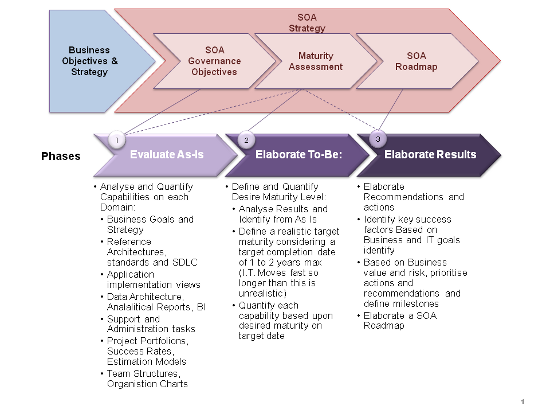
In order to gather all the information in a structured way and to subsequently quantify the results in a meaningful fashion, the Oracle Maturity Model was employed. The model was used to quantify each capability domain using a tool created by the company. This allowed the CIO to obtain an accurate view of the "As-Is" situation and to develop and quantify a realistic "To-Be" model.
The CIO set aside a period of three weeks (one week per phase) for the execution of the assessment, the elaboration of recommendations and the resulting SOA Roadmap. As the timeframe was very aggressive, it was agreed that the organization should commission the consultancy services of a niche player with a background in SOA and SOA Governance.
The phases of the assessment consisted of the following:
- Evaluate the As-Is: This phase consisted of gathering current information from each capability domain and quantifying it as accurately as possible. The main deliverable of this phase was the assessment model populated with the As-Is data.
- Evaluate the To-Be: In this phase, a target maturity level was defined for each capability based upon realistic and viable assumptions. For example, a period of one year was assumed as the target period to achieve the desired maturity. It was considered that a longer period might prove too long in a rapidly evolving market and would result in W&B losing its competitive edge in the retail space.
- Elaborate the results: In this phase, the outcome of the maturity assessment was mapped to a SOA Roadmap by specifying how the gap between the As-Is and the To-Be could be addressed.
The results
The results of the SOA Maturity Assessment mentioned in the previous section were as shown in the following diagram:
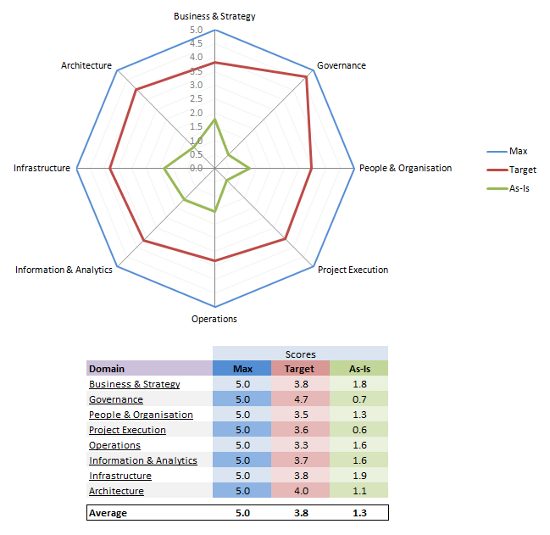
The consultancy conducting the maturity assessment identified a number of key challenges as follows:
- The IT department has grown immaturely while trying to constantly react to the demands placed on it by strong retail sales. Consequently, there has been a lack of overall architecture and governance, with IT developments being very tactical in nature. Each business unit within Weir & Bell Telecom has commissioned and developed its own IT systems with little regard for what had already been developed previously.
- Partly due to the lack of architecture and visibility over existing assets, many IT projects have been delivered late and there has been little reuse of existing assets. This has resulted in a poor perception of IT by key business stakeholders.
- Development teams have had little guidance; immature processes and an ill-defined software development lifecycle have resulted in estimates for development being at best optimistic and at worst poorly thought through. This has caused severe problems to the business as IT systems are continually developed late despite best intentions and lots of overtime. Poor estimation models and lack of architecture were identified as key contributors to poor planning, execution, and dependency management.
- SOA has not lived up to expectations with duplicate services being developed on a per-project basis with virtually no reuse of existing assets. This was attributed to the distinct lack of overall governance.
- In occasions, services were being overused, meaning used above the maximum throughput for which the service was designed to support. This resulted in performance penalties in the SOA infrastructure and therefore damaging the user experience.
The assessment concluded that, in order to bring the current maturity level of 1.3 to the required level of 3.8, strong architecture and a new governance framework were required. This would result in other dependent disciplines being intrinsically matured (such as project management and support). The following diagram illustrates the identified health status of the different areas of Governance when compared to a Reference Governance Framework:
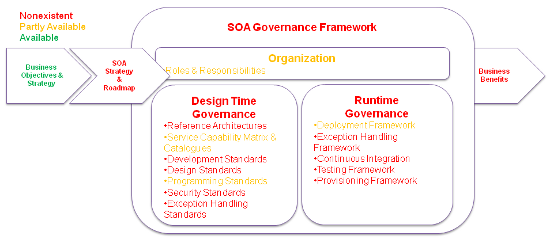
Furthermore, the outcome of the assessment suggested that, because of a lack of overall strategy and almost nonexistent design-time and runtime governance, SOA initiatives had failed to deliver any measurable business benefits.
The objectives
The CIO responded to the results of the SOA Maturity Assessment by creating an enterprise architect team whose responsibility was to ensure that business needs were clearly reflected in all future IT development efforts, and that the underlying infrastructure was able to scale to meet business demands. The team was also responsible for rationalizing existing systems and services and for reducing or removing redundancy.
One of the first actions for the architecture team was to create a reference architecture that specified a blueprint for all IT systems within Weir & Bell Telecom. The reference architecture supported IT agility by putting SOA at the heart of system development. This would allow the IT department to keep pace with the demands of the business moving forward and facilitate the introduction of new sales channels as identified in the business strategy for growth.
The enterprise architecture team also set out clear objectives for SOA Governance. Moreover, it was concluded that, in order to achieve these objectives, appropriate tooling would be required to support the desired processes and responsibilities. While the targeted objectives of the framework were known (as it can be appreciated from the following diagram), the tools needed to support these objectives was yet to be determined. Invitations to tender were consequently sent out to the main software vendors and a selection process was undertaken to determine which could provide the infrastructure required to underpin the governance effort.
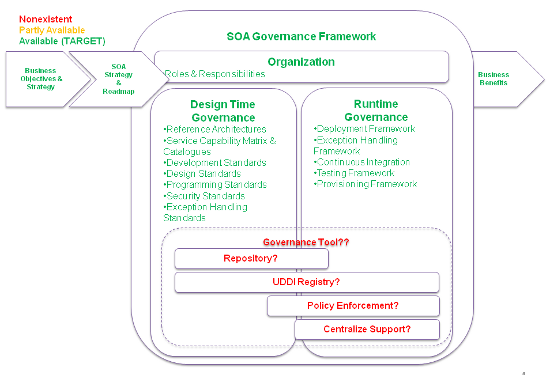
A key driver for product selection was support for design-time governance, encompassing service discovery, and cataloging for reuse, dependency management, service lifecycle, and support for the enforcement of policies and standards. The product was also required to support effective runtime governance with support for a common UDDI registry, runtime policy enforcement (including security), exception handling, service deployment, and system monitoring.
After an exhaustive product selection exercise, the Oracle SOA Governance Solution was chosen as the preferred software toolset to support the implementation of SOA Governance at Weir & Bell Telecom.
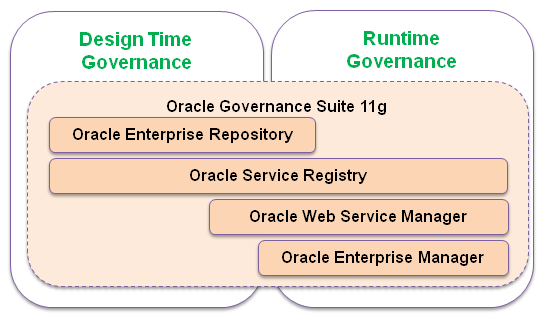
As the preceding diagram suggests, the decision was made mainly for two reasons. Firstly, the product offering from Oracle was extremely strong at supporting design-time and runtime Governance, and therefore was highly aligned with the team's objectives for its governance effort. Secondly, as Oracle already had a considerable footprint in the technology landscape at Weir & Bell telecom, it was concluded that implementing the Oracle SOA Governance Solution would have considerable benefits as these products were certified to integrate with other Oracle Fusion Middleware products already implemented in the company, such as the Oracle SOA Suite 11g.
The business case
The enterprise architecture team, under the guidance of the new CIO, created a compelling business case that was presented in the board of directors at Weir & Bell Telecom. The outcome of this presentation was pivotal to transforming the image of the IT department, which was perceived as being inefficient and slow to react to business changes, and also to secure any needed funding.
SOA was at the heart of the business case. The CIO recognized SOA to be the primary vehicle for introducing the agility required to meet the aggressive demands placed on the IT function by the retail arm of Weir & Bell Telecom. The maturity assessment was an essential part of the business case and it gave the CIO a real understanding of the strengths and weaknesses of his department and allowed him to focus on areas that needed to be addressed immediately. The alignment of IT strategy to business strategy was fundamental to realizing maximum return on investment (ROI) in terms of services and infrastructure.
The business case, together with supporting evidence gathered during the SOA Maturity Assessment, highlighted how real synergy between IT and the business could result in automation and improvement of vital processes in the supply chain. Rationalization of the underlying infrastructure and a move to virtualization, together with the elimination of redundancy in terms of software applications and services across business units, could lead to significant cost savings across the organization.
The following diagram depicts how a governed SOA implementation could significantly reduce the number of integration points and hand-offs between business units, paving the way to increased process efficiencies and cost savings:
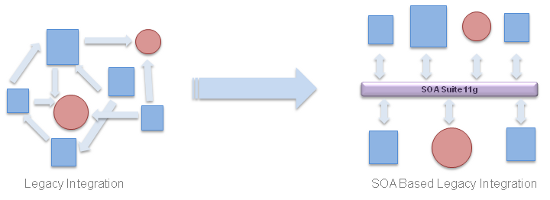
The business case discussed how the introduction of Oracle Enterprise Repository to support design-time Governance was essential to ensuring that services were rationalized across the enterprise. Better insight into existing services together with the introduction of design patterns as part of the governance effort would give rise to services that were more granular and more consumable for new processes. This in turn would allow IT to introduce new sales channels by utilizing existing services that communicated with back end order and logistics systems. It described how the reuse of service assets led to the decreased cost of development while the introduction of a new Software Development Lifecycle (SDLC) and continuous integration would lead to better quality software being produced by developers. This in turn would have a huge impact on the test department who were traditionally viewed in a bad light by management. Previously, quality was almost invariably introduced at the testing stage as testers battled with poor quality code leading to a huge testing cycle that in turn led to late delivery of software and increased costs.
The Oracle Enterprise Repository combined with the Oracle Service Registry to enhance runtime Governance allowed Weir & Bell Telecom to share its services with third parties and preferred suppliers, leading to further efficiency savings in the supply chain processes. It illustrated how a large number of requisitions could be automatically raised when supplies fell below a threshold value; depending on business rules, some could even be automatically approved and sent to suppliers without human intervention. This would lead to much smoother delivery of important components and reduced component lead time while allowing the manufacturing department to have a far better control of inventory; all key factors in allowing the business to react to successful marketing and sales campaigns.
Subsequent sections of the business case focused on justifying the cost of implementing governance and illustrated how the benefits would outweigh any spending in a relatively short period of time. This provided the board with key metrics for return on investment. It documented how savings could be realized in different areas. For example, on the current SOA implementation there was little or no reuse of existing services. Huge savings could be realized in the software development costs (CAPEX), by promoting code reuse by strict design-time Governance and by enforcing policies using Oracle Enterprise Repository.
The business case also showed how reuse and policy enforcement would have a positive impact on operating support costs (OPEX), since with proper governance the number of services would increase gradually and not exponentially. Therefore, fewer people are required to support the services and also tasks that are usually complex, such as troubleshooting, would become more predictable since all services would implement known patterns and utilize a common exception handling framework. It is further explained that, by employing Oracle Web Services Manager (OWSM) to secure services in the production environment, the code itself could be separated from the security implementation, bringing with it the ability to declaratively define security for all service implementations, and delegate definition of security policies to the security department. OWSM also provided the ability to monitor whether SLAs were being met.
Another key justification presented in the business case centered around how critical business logic embedded in old and extremely complex legacy systems could be extracted and presented as web services, and could be utilized in key value chain processes. The SOA layer would be used to provide an abstraction layer between legacy systems and the business processes themselves. This would allow the legacy applications to be replaced at a later date without having to change the process itself. The impact of change would be absorbed by the service implementation and transformation logic, the process being unaffected as the service interface would not change. This would, in turn, facilitate legacy modernization that was attractive to the board of directors and it served to illustrate how SOA could be used in different ways to deliver business benefits.
Moving forward, all service implementations would be written to exacting standards to ease their consumption in the future processes and Oracle Enterprise Repository would act as a single source of truth for the SOA portfolio. Architects and analysts would be able to use the repository for version control, dependency tracking, impact analysis, and service discovery and cataloging. In short, the entire service lifecycle would be properly governed both at design-time and at runtime.
Unlock access to the largest independent learning library in Tech for FREE!
Get unlimited access to 7500+ expert-authored eBooks and video courses covering every tech area you can think of.
Renews at $19.99/month. Cancel anytime
The business case concluded by explaining how SOA Governance would lead to better management of the heterogeneous SOA landscape and would deliver greater visibility of end-to-end service networks and better tracking of usage, allowing the IT department to report on return on investment for SOA assets across the enterprise. All of this would ultimately transform into benefits to the business in the form of costs savings and greater flexibility. In short, a win-win situation for the business.
The business case was presented to the board of directors and the feedback was very positive. The budget to begin the roadmap activities was approved. However, the board demanded that all benefits, as documented on the business case, should be supported with critical success factors that could be measured at different checkpoints throughout the SOA program.
Critical success factors
Based on the feedback from the board of directors, the new CIO of Weir & Bell Telecom placed the monitoring and measurement of critical success factors and business metrics at the heart of the architectural effort. By aligning the IT strategy with the business strategy and being able to report back to the board on the return on investment for IT-related projects, he would be able to demonstrate the effectiveness of IT across the enterprise. The key here was to prove that the use of SOA would result in significant cost savings while also increasing development productivity and reducing software maintenance costs. The resulting performance improvements were expected to have a significant impact on business agility and enable the organization to respond quickly to competitive challenges.
The critical success factors for the architectural effort were heavily reliant on the fact that development and support costs would be reduced by enforcing governance, most notably in the reuse of existing SOA assets. The reasoning behind this proposition is explained in the following paragraphs.
A SOA asset's estimated value is based on the development costs avoided by reusing rather than recreating. By reusing existing assets, an organization avoids both the costs of repeatedly developing the same functionality and the cost of maintaining different implementations of the same functionality. Thus, re-use consolidates functionality and reduces redundancy. The more that re-use occurs, the greater the savings as the diagram suggests.
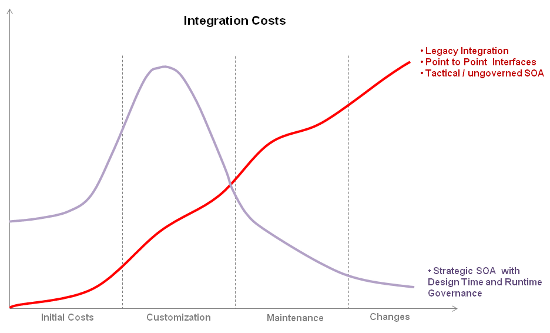
The difference between the time a developer would spend building an asset for single use and the time needed to use a reusable version of that asset is referred to as Predicted Net Hours Saved. This represents the development cost avoided through re-use of the asset. The following formula was used to make these calculations:

Establishing the expected ROI of assets within the portfolio requires consideration of the annual usage of each asset, and the conversion of the total Predicted Net Hours Saved to a monetary value.
An enterprise registry/repository with the appropriate capabilities is essential in tracking progress towards organizational SOA and re-use goals. It should be utilized to track each Asset's value, state (defined, designed, implemented, upgraded, and retired); then, as Assets are used, the registry/repository should gather the necessary data to generate reports that details an Asset's value. This provides a way for organizations to compare the estimated ROI to the actual returns in an SOA initiative.
While reusable assets may vary in their size, scope, and purpose, their estimated valuation and the accurate reporting of their actual value are essential in guiding SOA Governance efforts to ensure sustainable alignment with business goals.
SOA Governance is essential for increasing the value of assets by insuring their alignment with and support of policies and standards as established at the architectural, IT, and corporate levels.
An asset's value is determined not solely by its reusability or re-use, but also by the contribution it makes in moving the organization toward its business goals. To that end, the importance of effective SOA lifecycle governance in guiding the design, development, support, and retirement of assets cannot be overstated.
A new reference architecture
The enterprise architecture team began by creating a new reference architecture that would be strongly aligned to the business strategy. This is presented in the following diagram:

The IT strategy was developed with the target operating model in mind including the requirement for new sales channels. The underlying infrastructure was ported to a private cloud-based model to allow for the rapid growth predicted by the business and also in light of expected acquisitions that were due to be made over the coming years. SOA was endorsed as the preferred architectural style for software development with existing and new commercially available and off-the-shelf (COTS) products having little or no customizations moving forward.
Proposed IT developments were assessed and aligned to the IT strategy with a number of projects scrapped and new initiatives introduced.
The new governance process
A new governance process was introduced across the enterprise to reduce redundancy of all software development efforts between business units. A clearly defined SOA Roadmap was created indicating how the current state of the IT organization could move as efficiently as possible to the new To-Be model.
A whole suite of governance standards was created, documented, and distributed to the development teams. These standards clearly specified the development, programming, and deployment standards that were to be adopted for all SOA initiatives enterprise wide.
Design-time governance was introduced, covering all aspects of service discovery, design, versioning, and decommissioning. The Oracle Enterprise Repository was introduced to support design-time Governance by ensuring that all service metadata and XML artifacts were accessible across the enterprise in an effort to promote re-use, and therefore to ensure that key benefits were realized from existing investment in services.
Oracle Enterprise Repository was also used to harvest assets enterprise-wide, ensuring that existing investment was not lost as part of the governance initiative.
Oracle JDeveloper was already used by the development teams for creating services. Integration of the JDeveloper SOA development environment with the Repository and Service Registry was seen as a key requirement to enable developers to access and synchronize between the repository and the development environment to automatically harvest assets and enhance productivity.
Runtime governance standards were defined and documented. A new deployment framework was created to standardize system set up and service deployment. This would enable IT infrastructure to grow efficiently as the business demands increased. Oracle Service Registry was introduced to facilitate rapid discovery and consumption of existing services.
Improved visibility
Another key recommendation highlighted as part of the SOA Maturity Assessment was the requirement to improve runtime visibility of SOA assets. As a result, the runtime engines (such as the Oracle Service Registry and Oracle Enterprise Manager) were integrated with Oracle Enterprise Repository to ensure that key metrics around service utilization and service re-use were feedback into the asset's details page. Having design-time and runtime systems integrated, empowered project managers, SOA architects, and designers to enforce policies around service re-use, which ultimately accounted in savings to the company.
Standardized error reporting and system monitoring was introduced with Oracle Enterprise Manager (OEM) being adopted across the enterprise. Business Activity Monitoring (BAM) was also introduced on selected business processes, following a review of business metrics and key performance indicators with the business. Oracle BAM and OEM gave the support team increased visibility into application performance and availability, allowing them to more proactively monitor problems and suggest improvements to a number of key business processes. In some cases, process lifecycles were decreased by as much as 60 percent and cost savings in one area ran into thousands of pounds. This exercise rapidly improved the availability of essential services and processes, which in turn provided a genuine real good factor to the business. The latter was important as the board started to fund further process improvement projects.
Furthermore, continuous integration was implemented so that software was tested regularly ensuring that the quality of software was much higher than had previously been the case.
The SOA Roadmap highlighted further areas of business automation and senior business executives were able to understand and digest how IT could now work hand in hand with the business to introduce real cost savings and to streamline the supply chain further.
The exercise conducted for identifying key business metrics and KPIs also helped the business to focus on important processes that were key to the success of Weir & Bell Telecom. Understanding the business metrics helped the stakeholders to stop and realize a number of business improvements particularly in areas where previously hand-offs between business units were creating unnecessary delays and inefficiencies. Very importantly, IT and the business now had the ability to measure, qualitatively and quantitatively, key business areas, allowing the board for the first time to have a real understanding of the impact of IT investment moving forward. This could range from bottom line costs savings to simply improving the lives of some of its staff by freeing them from tasks that could otherwise be automated, thus freeing them up for more value-added activities.
Summary
In this article we described a case study based on a real live SOA Governance implementation as experienced by the authors. The article illustrated how the governance concepts such as maturity assessments, reference architectures, SOA assets, and design-time and runtime Governance, were put into practice in order to successfully implement SOA Governance into an organization.
This article emphasized the importance of having the right level of sponsorship and buy-in from the business before embarking on a governance implementation. This was achieved up front, since without business sponsorship the benefits that SOA can bring to the table would have not been visible or achievable. Additionally, the article described how by presenting a business case with clear business benefits and objectives it was possible to qualitatively and quantitatively measure success. This in turn allowed the board of directors to understand the positive impact that IT and SOA can bring to business.
The article concluded by describing how the Oracle SOA Governance toolset was implemented alongside the company's existing Oracle SOA and technological landscape in order to deliver design-time and runtime Governance.
Resources for Article:
Further resources on this subject:
 United States
United States
 Great Britain
Great Britain
 India
India
 Germany
Germany
 France
France
 Canada
Canada
 Russia
Russia
 Spain
Spain
 Brazil
Brazil
 Australia
Australia
 Singapore
Singapore
 Canary Islands
Canary Islands
 Hungary
Hungary
 Ukraine
Ukraine
 Luxembourg
Luxembourg
 Estonia
Estonia
 Lithuania
Lithuania
 South Korea
South Korea
 Turkey
Turkey
 Switzerland
Switzerland
 Colombia
Colombia
 Taiwan
Taiwan
 Chile
Chile
 Norway
Norway
 Ecuador
Ecuador
 Indonesia
Indonesia
 New Zealand
New Zealand
 Cyprus
Cyprus
 Denmark
Denmark
 Finland
Finland
 Poland
Poland
 Malta
Malta
 Czechia
Czechia
 Austria
Austria
 Sweden
Sweden
 Italy
Italy
 Egypt
Egypt
 Belgium
Belgium
 Portugal
Portugal
 Slovenia
Slovenia
 Ireland
Ireland
 Romania
Romania
 Greece
Greece
 Argentina
Argentina
 Netherlands
Netherlands
 Bulgaria
Bulgaria
 Latvia
Latvia
 South Africa
South Africa
 Malaysia
Malaysia
 Japan
Japan
 Slovakia
Slovakia
 Philippines
Philippines
 Mexico
Mexico
 Thailand
Thailand























